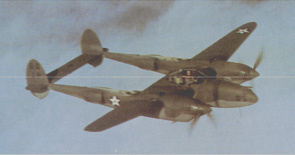Lockheed P-38 Lightning
United States | Bell P-39 | Bell P-59 | Bell P-63 | Brewster F2A | P-36 Hawk | P-40 Warhawk | F4F Wildcat | F6F Hellcat | F7F Tigercat | F8F Bearcat | P-38 Lightning | Lockheed P-80 | P-51 Mustang | P-61 Black Widow | P-47 Thunderbolt | F4U Corsair
P-38 Lightning
During the 1930s, several countries were developing or testing large, twin engined single seat fighters. The most interesting and successful was the Lockheed P-38 Lightning, with its curious twin boom tails. It would eventually become known as Der Gabelschwanz Teufel (Fork Tailed Devil) over the skies of Europe. The P-38 began as Lockheed design No. 22 in accordance with a USAAF specification for a high altitude interceptor capable of high speeds. Lockheed developed a single engined airframe for Model No 22, but no engine was available to meet the speed requirements of the USAAF. The only solution was for two engines to be used, and the unorthodox twin boom configured airframe was born. In June of 1937, a prototype was ordered and it was designated the XP-38.
Because the engines were in the booms, the entire nose section was free to be filled with guns and cannon. The proposed armament of one 23mm cannon and six 50-calibre machine guns was extremely powerful for the day One problem the Lockheed designers ran into was the torque from the two engines would move the aircraft too much and require the pilot to constantly apply left aileron to keep the aircraft flying straight. To solve this problem, a special design of the Allison 1,100hp engine was laid out to drive one propeller to the left, while the other spun the prop to the right. In mid 1940, large scale production orderes of the XP-38 had been ordered, both from the USAAF and the RAF.
The YP-38 met the requirements for speed when it hit 405mph and climbed to 20000 feet in six minutes. Instead of the 23mm cannon, a 37mm piece was installed and two of the 50-calibre machine guns switched for .303s instead. This armament was soon again revised to the standard four 50s and one 20mm cannon. In the beginning of US involvment in WW2, it was the P-38, together with the P-39 and P-40, that constituted the only modern aircraft America had at that time. The P-39 soon was taken out of fighter service, and the P-40 was already rather obsolete, which left the P-38 to take the brunt of the Axis powers until the P-51 and P-47s were developed.
Use of the P-38 was extensive in the US fronts. Perhaps the most famous mission of the P-38 was in 1943, when they intercepted the bomber carrying Japanese Admiral Yamamoto and shot it down. P-38s were used in both theatres as escorts and as fighter-bombers, night fighters, and a few models were stripped of their guns and given a bombardeir in the nose section with a bomb sight. Still more were given radar and cameras.
Specifications for P-38J Lightning:
Type: Single Seat 2-engined fighter/bomber
Engines: Two Allison V-1710 Vee 12 liquid cooled inlines
Dimensions: Span 52ft; length 37ft 10in; height 12ft 10in.
Weights: empty 11,000lbs; loaded 14,300lbs.
Performance: Max Speed 414mph; ceiling 38,000feet; range 2,260 miles.
Armament: One 20mm cannon and four .50-calibre machine guns
Nations: France, Great Britain, United States

P-38 Lightning